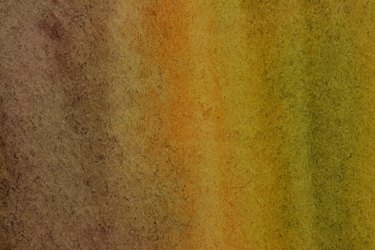
The medium an artist paints with has a direct effect on the resulting work. Watercolors and oil paints are an excellent example of this. The look, feel and style of a painting can change dramatically from medium to medium. Even two paintings of the same subject can differ greatly between the two mediums. Identifying which paintings are created with watercolors and which with oils requires understanding what makes the two paints different and how that affects the resulting textures and colors.
Paint
Video of the Day
Watercolors use water as the vehicle for the pigments. The paint is mixed with water and transferred to paper or other suitable surface using a brush. As the water dries, the paint is left bonded to the painting surface. Oil paints are made of various pigments suspended in drying oil. The potential thickness of oil paint allows it to be transferred and manipulated using not only brushes but also palette knives and rags. Rather than evaporating, as in watercolors, the oil hardens when exposed to air, solidifying the paint.
Video of the Day
Detail
While a skilled painter can use either medium to mimic the other, the two types of paint produce a distinct look. This look is in part due to techniques required to manipulate them. Watercolors are a very fluid medium that dries rapidly. An artist must work to control the flow and absorption of the paint in order to produce the desired result. Oil paints can be mixed to become thinner or thicker, and they dry very slowly. Because of this the painter has more control over oil paint and is better able to craft fine detail. While not always the case, a painting with a lot of small vivid detail is more likely to be oil than watercolor.
Texture
Typically, the most telling difference between a watercolor painting and an oil painting is the texture of the painting's surface. Watercolor paint doesn't have any texture of its own or is very thin, often taking on the texture of the surface beneath it. With oils, the texture of the painting can be directly shaped by the artist's tools and may appear to be raised slightly from the painting surface. While both mediums may contain visible brush strokes in the paint, only the oil painting's brush strokes have actual physical depth and visible layers. Raised layers of paint are a clear indication that the painting is not watercolor.
Color
Both watercolor paintings and oil paintings are known for their color. The way the colors display is a strong way to tell the difference between the mediums. Watercolors are a primarily translucent medium, which allows underlying colors to show through each layer. The colors typically have a delicate and organic appearance. Edges of color may appear soft or fuzzy, similar to a coffee stain on paper. Oil paints potentially have richer, more luminescent colors, as the medium allows for thicker paint.